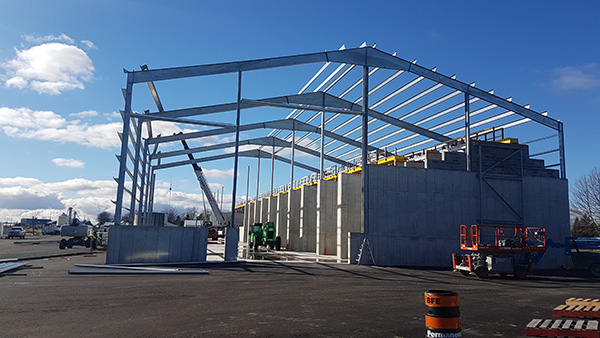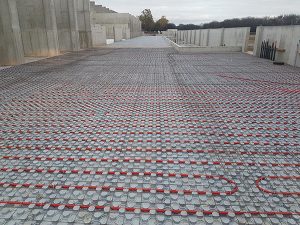
In-floor Heating Provides Reliable Storage Solution
September 29, 2021 | By Courtesy REHAU
Radiant heating used for temperature and condensation control in agricultural fertilizer warehouse.

A 20,000 sq. ft. fertilizer warehouse with in-floor radiant heating (photo: courtesy IFH Design and Installation)
Belmont Farm Supply, located about 116 miles outside of Toronto in Belmont, Ont, provides fertilizer, crop protection products, seed as well as custom application and delivery services to farmers in Elgin, Middlesex and Oxford Counties in the southwest region of the province. It has been part of the area’s farming community since the 1940s.
When owner-partners Graham Hutton, Brad Walker and Jeff Aarts decided to build a new fertilizer warehouse, they wanted a state-of-the-art building to maintain the floor at a constant temperature. “We were trying to keep the moisture from forming on the concrete when the humidity rises,” Walker notes.
A floor temperature between 57F and 60F (14C and 16C) is essential when storing fertilizer. A lower floor temperature that allows outside temperatures to rise above it causes risk of condensation that can turn the fertilizer from a solid to a liquid.
Walker selected St. Marys, Ont.-based iFH Design and Installations, headed up by Paul McRoberts with team members Brent McRoberts, Nick Muir and Andrew Wilhelm, to design and install the radiant floor heating system.
McRoberts is a 47-year veteran in hydronic heating; after beginning as an apprentice in 1972, he opened his own business in 1984 and was one of the first hydronic contractors in southwest Ontario to work with, and eventually specialize in, radiant floor heat. McRoberts says about 90% of iFH’s business is radiant floor heating projects.
Don’t forget the insulation
The ceiling height of the steel-constructed building is more than 36 ft (11 m). The concrete slab is 372 x 96 ft. More than four miles (6.6 km) of PEX was installed in the building, McRoberts notes. The radiant system uses piping in ¾-, 1-, 1-1/4-, 1-1/2- and 2-in. sizes; 1 1/4-in. stainless-steel manifolds; 3/4-in. connectors; and compression-sleeve fittings.
“Instead of doing all the large diameter supply and return piping above, we did it all below ground with 2-in. and 1-1/2-in. oxygen-barrier piping with the fittings,” McRoberts explains. “Then we insulated all the piping with 1-in. foam insulation made for underground use.”

Two-inch expanded polystyrene panels double as insulation and a piping-installation method.
The next step was the placement of 2-in. expanded polystyrene panels that double as insulation and a piping-installation method. The 3/4-in. by 500-ft loops were walked into place on top of the boards at 9-in to 12-in spacing then connected to the manifolds. A 40% glycol solution runs through the PEX network.
From the boiler room, all manifolds were supplied with 1-1/2-in. oxygen barrier supply lines. The longest supply lines were nearly 300 ft from the heat source.
“In each area of the manifolds, we installed floor sensor wells with PEX piping so we could insert our sensors in after the concrete was installed,” he says. “Before the concrete pour, the floor piping was pressurized to 100 psi to ensure there were no leaks under the floor, which also included the 1-1/2-in. and 2-in. in-slab distribution piping.”
In the mechanical room, two IBC boilers are the heat source for the radiant heating system — providing nearly 800,000 Btu/h of energy to maintain the required floor temperature, McRoberts notes. Low-loss headers and a hydronic dirt separator provide hydraulic separation and protect the components. A high capacity circulator distributes water to the five manifold stations. Isolation flange kits and floor sensing and pump controls round out the installed equipment.
Quality and reliability
Opening in April 2019, the owners have been through winter seasons with the warehouse full and fine-tuned the floor temperatures in the spring. “We are extremely happy that we have the heated floor,” Walker says. “It certainly helps maintain the quality of our products.”




